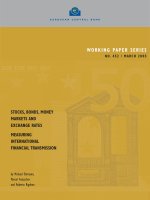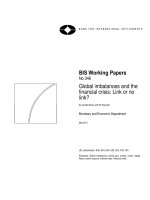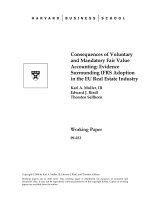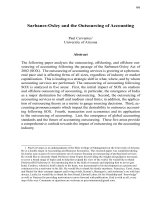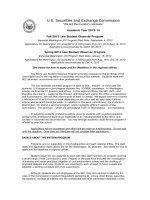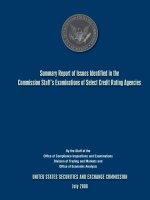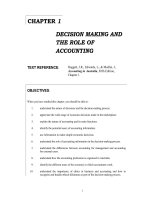SECURITIES AND EXCHANGE COMMISSION: Staff Accounting Bulletin No. 104 pptx
Bạn đang xem bản rút gọn của tài liệu. Xem và tải ngay bản đầy đủ của tài liệu tại đây (381.83 KB, 81 trang )
SECURITIES AND EXCHANGE COMMISSION Corrected Copy
17 CFR Part 211
[Release No. SAB 104]
Staff Accounting Bulletin No. 104
AGENCY: Securities and Exchange Commission.
ACTION: Publication of Staff Accounting Bulletin.
SUMMARY: This staff accounting bulletin revises or rescinds portions of the
interpretative guidance included in Topic 13 of the codification of staff accounting
bulletins in order to make this interpretive guidance consistent with current authoritative
accounting and auditing guidance and SEC rules and regulations. The principal revisions
relate to the rescission of material no longer necessary because of private sector
developments in U.S. generally accepted accounting principles.
This staff accounting bulletin also rescinds the Revenue Recognition in Financial
Statements Frequently Asked Questions and Answers document issued in conjunction
with Topic 13. Selected portions of that document have been incorporated into Topic 13.
DATE: December 17, 2003
FOR FURTHER INFORMATION CONTACT: Chad Kokenge or Shelly Luisi in the
Office of the Chief Accountant (202) 942-4400, Securities and Exchange Commission,
450 Fifth Street, NW, Washington, DC 20549-1103.
SUPPLEMENTARY INFORMATION: The statements in staff accounting bulletins are
not rules or interpretations of the Commission, nor are they published as bearing the
Commission’s approval. They represent interpretations and practices followed by the
1
Division of Corporation Finance and the Office of Chief Accountant in administering the
disclosure requirements of the Federal securities laws.
Margaret H. McFarland
Deputy Secretary
Date: December 17, 2003
Part 211 – (AMEND)
Accordingly, Part 211 of Title 17 of the Code of Federal Regulations is amended
by adding Staff Accounting Bulletin No. 104 to the table found in Subpart B.
STAFF ACCOUNTING BULLETIN NO. 104
[
Note: The text of SAB 104 will not appear in the Code of Federal Regulations.]
The staff hereby revises Topic 13 of the Staff Accounting Bulletin Series as
follows:
1. Topic 13.A.1 is modified as follows:
a. The examples of existing literature referenced in the first paragraph are
deleted.
b. The last paragraph, including footnote 7, is added to make reference to
EITF Issue 00-21, “
Revenue Arrangements with Multiple
Deliverables,” which governs how to determine if revenue
arrangements contain more than one unit of accounting.
2. Topic 13.A.2 is modified as follows:
a. Question 3 (formerly Question 1 of the staff’s Revenue Recognition in
Financial Statements Frequently Asked Questions and Answers
document (FAQ)) is added.
2
3. Topic 13.A.3 is modified as follows:
a. The subheading Bill and hold arrangements is added.
b. Topic 13.A.3(a) Question is formerly Question 3.
c. The subheading
Customer acceptance is added.
d. Topic 13.A.3(b) Question 1 (formerly Question 5 of the FAQ) is
added. The question format is conformed.
e. Topic 13.A.3(b) Question 2 (formerly Question 6 of the FAQ) is
added. The facts, question and interpretive response are modified to
reflect the evaluation of the arrangement in the context of separate
units of accounting. In addition, the last paragraph of the interpretive
response is deleted due to the issuance of EITF Issue 00-21.
f. Footnote 29 is added to highlight that the changes to Topic 13.A.3(b)
Question 2 are to facilitate an analysis of revenue recognition, not
interpret EITF Issue 00-21.
g. Topic 13.A.3(b) Question 3 (formerly Exhibit A Example 1 Scenario
A of the FAQ) is added.
h. Topic 13.A.3(b) Question 4 (formerly Exhibit A Example 1 Scenario
B of the FAQ) is added.
i. Topic 13.A.3(b) Question 5 (formerly Exhibit A Example 1 Scenario
C of the FAQ) is added.
j. The subheading
Inconsequential or perfunctory performance
obligations is added.
3
k. Topic 13.A.3(c) Question 1 (formerly Question 2 of the FAQ) is
added. The question and interpretive response are modified from the
FAQ to reflect the evaluation of the arrangement in the context of a
single unit of accounting. The question format is conformed.
l. Topic 13.A.3(c) Question 2 (formerly Question 3 of the FAQ) is
added. The question and interpretive response are modified from the
FAQ to reflect the evaluation in the context of a single unit of
accounting.
m. Topic 13.A.3(c) Question 3 (formerly Question 7 of the FAQ) is
added. The facts, question and interpretive response are modified to
reflect the evaluation of the arrangement in the context of combined
deliverables, which result in a single unit of accounting. In addition,
the interpretive response is modified to delete the last four sentences as
this guidance is no longer necessary due to the issuance of EITF 00-
21.
n. The segue sentence and related footnote discussing delivery or
performance of multiple deliverables is deleted to eliminate
redundancy.
o. The subheading
License fee revenue is added.
p. Topic 13.A.3(d) Question (formerly Question 9 of the FAQ) is added.
The interpretive response is modified to eliminate redundancy.
q. The subheading
Layaway sales arrangements is added.
r. Topic 13.A.3(e) Question is formerly Question 4.
4
s. The subheading
Nonrefundable up-front fees is added.
t. The examples in Topic 13.A.3(f) Question 1 (formerly Question 5) are
modified to include the examples from what was formerly Question 10
of the FAQ. Guidance in the interpretive response is added and
conformed from Question 10 of the FAQ which clarifies the
incurrence of substantive costs does not necessarily indicate there is a
separate earnings event, and that the determination of a separate
earnings event should be evaluated on a case-by-case basis.
u. Footnote 36 is added to clarify the staff’s view regarding the vendor
activities associated with up-front fees.
v. Topic 13.A.3(f) Question 2 (formerly Question 6) is modified to
reflect the evaluation in the context of a single unit of accounting.
w. Footnote 29 is deleted. The subject matter of footnote 29 is conformed
and included in Topic 13.A.3(f) Question 3; accordingly, Topic
13.A.3(f) Question 3 reflects the guidance formerly located in footnote
29.
x. Topic 13.A.3(f) Question 4 (formerly Question 15 of the FAQ) is
added. The question format is conformed.
y. Topic 13.A.3(f) Question 5 (formerly Question 16 of the FAQ) is
added. The question format is conformed.
z. The subheading
Deliverables within an arrangement is added.
5
aa. Topic 13.A.3(g) Question (formerly Question 8 of the FAQ) is added
and is modified to reflect the evaluation of the question under EITF
Issue 00-21.
bb. Footnote 45 is added to clarify the staff’s view of the obligation
described in Topic 13.A.3(g) Question under FIN 45.
4. Topic 13.A.4 is modified as follows:
a. The subheading
Refundable fees for services is added.
b. Topic 13.A.4(a) Question 1 is formerly Question 7.
c. Footnote 56 is added to include guidance from Question 23 of the
FAQ.
d. Topic 13.A.4(a) Question 2 (formerly Question 18 of the FAQ) is
added.
e. Topic 13.A.4(a) Question 3 (formerly Question 19 of the FAQ) is
added. The question format is conformed.
f. Topic 13.A.4(a) Question 4 (formerly Question 20 of the FAQ) is
added.
g. Topic 13.A.4(a) Question 5 (formerly Question 21 of the FAQ) is
added. The question format is conformed.
h. Topic 13.A.4(a) Question 6 (formerly Question 22 of the FAQ) is
added.
i. The subheading
Estimates and changes in estimates is added.
j. Topic 13.A.4(b) Question 1 is formerly Question 9.
6
k. Topic 13.A.4(b) Question 2 (formerly Question 24 of the FAQ) is
added.
l. Topic 13.A.4(b) Question 3 (formerly Question 25 of the FAQ) is
added. The question format is conformed. The last two sentences of
the interpretive response are deleted to eliminate redundancy.
m. Topic 13.A.4(b) Question 4 (formerly Question 26 of the FAQ) is
added.
n. Topic 13.A.4(b) Question 5 (formerly Question 27 of the FAQ) is
added.
o. The subheading
Contingent rental income is added.
p. Topic 13.A.4(c) Question is formerly Question 8.
q. The subheading
Claims processing and billing services is added.
r. Topic 13.A.4(d) Question (formerly Question 28 of the FAQ) is added.
The facts are modified to reflect to evaluation in the context of a single
unit of accounting.
5. Topic 13.A.5 is deleted. This topic provided guidance on income statement
presentation and whether transactions should be presented on a gross as a
principal or net as an agent basis. EITF Issue 99-19, “
Reporting Revenue
Gross as a Principal versus Net as an Agent”, which was issued subsequent to
SAB 101, provides such guidance. Therefore, this guidance is no longer
necessary.
6. Topic 13.B is modified as follows:
7
a. The interpretive response to Question 1 is modified to reference
multiple units of accounting in lieu of multiple elements.
b. Question 2 is modified to delete the reference to Question 10 of Topic
13.A and Topic 8.A.
c. Question 3 (formerly Question 29 of the FAQ) is added.
d. Question 4 (formerly Question 30 of the FAQ) is added.
e. Question 5 (formerly Question 31 of the FAQ) is added.
8
Topic 13: REVENUE RECOGNITION
A. Selected Revenue Recognition Issues
1.
Revenue recognition - general
The accounting literature on revenue recognition includes both broad conceptual
discussions as well as certain industry-specific guidance.
1
If a transaction is within the
scope of specific authoritative literature that provides revenue recognition guidance, that
literature should be applied. However, in the absence of authoritative literature
addressing a specific arrangement or a specific industry, the staff will consider the
existing authoritative accounting standards as well as the broad revenue recognition
criteria specified in the FASB's conceptual framework that contain basic guidelines for
revenue recognition.
Based on these guidelines, revenue should not be recognized until it is realized or
realizable and earned.
2
Concepts Statement 5, paragraph 83(b) states that "an entity's
1
The February 1999 AICPA publication "Audit Issues in Revenue Recognition" provides an overview of
the authoritative accounting literature and auditing procedures for revenue recognition and identifies
indicators of improper revenue recognition.
2
Concepts Statement 5, paragraphs 83-84; ARB 43, Chapter 1A, paragraph 1; Opinion 10, paragraph 12.
The citations provided herein are not intended to present the complete population of citations where a
particular criterion is relevant. Rather, the citations are intended to provide the reader with additional
reference material.
9
revenue-earning activities involve delivering or producing goods, rendering services, or
other activities that constitute its ongoing major or central operations, and revenues are
considered to have been earned when the entity has substantially accomplished what it
must do to be entitled to the benefits represented by the revenues" [footnote reference
omitted]. Paragraph 84(a) continues "the two conditions (being realized or realizable and
being earned) are usually met by the time product or merchandise is delivered or services
are rendered to customers, and revenues from manufacturing and selling activities and
gains and losses from sales of other assets are commonly recognized at time of sale
(usually meaning delivery)" [footnote reference omitted]. In addition, paragraph 84(d)
states that "If services are rendered or rights to use assets extend continuously over time
(for example, interest or rent), reliable measures based on contractual prices established
in advance are commonly available, and revenues may be recognized as earned as time
passes."
The staff believes that revenue generally is realized or realizable and earned when all of
the following criteria are met:
• Persuasive evidence of an arrangement exists,
3
3
Concepts Statement 2, paragraph 63 states "Representational faithfulness is correspondence or agreement
between a measure or description and the phenomenon it purports to represent." The staff believes that
evidence of an exchange arrangement must exist to determine if the accounting treatment represents
faithfully the transaction. See also SOP 97-2, paragraph 8. The use of the term "arrangement" in this SAB
Topic is meant to identify the final understanding between the parties as to the specific nature and terms of
the agreed-upon transaction.
10
• Delivery has occurred or services have been rendered,
4
• The seller's price to the buyer is fixed or determinable,
5
and
• Collectibility is reasonably assured.
6
Some revenue arrangements contain multiple revenue-generating activities. The staff
believes that the determination of the units of accounting within an arrangement should
be made prior to the application of the guidance in this SAB Topic by reference to the
applicable accounting literature.
7
4
Concepts Statement 5, paragraph 84(a), (b), and (d). Revenue should not be recognized until the seller has
substantially accomplished what it must do pursuant to the terms of the arrangement, which usually occurs
upon delivery or performance of the services.
5
Concepts Statement 5, paragraph 83(a); Statement 48, paragraph 6(a); SOP 97-2, paragraph 8. SOP 97-2
defines a "fixed fee" as a "fee required to be paid at a set amount that is not subject to refund or adjustment.
A fixed fee includes amounts designated as minimum royalties." Paragraphs 26-33 of SOP 97-2 discuss
how to apply the fixed or determinable fee criterion in software transactions. The staff believes that the
guidance in paragraphs 26 and 30-33 is appropriate for other sales transactions where authoritative
guidance does not otherwise exist. The staff notes that paragraphs 27 through 29 specifically consider
software transactions, however, the staff believes that guidance should be considered in other sales
transactions in which the risk of technological obsolescence is high.
6
ARB 43, Chapter 1A, paragraph 1 and Opinion 10, paragraph 12. See also Concepts Statement 5,
paragraph 84(g) and SOP 97-2, paragraph 8.
7
See EITF Issue 00-21 paragraph 4 for additional discussion.
11
2.
Persuasive evidence of an arrangement
Question 1
Facts: Company A has product available to ship to customers prior to the end of its
current fiscal quarter. Customer Beta places an order for the product, and Company A
delivers the product prior to the end of its current fiscal quarter. Company A's normal and
customary business practice for this class of customer is to enter into a written sales
agreement that requires the signatures of the authorized representatives of the Company
and its customer to be binding. Company A prepares a written sales agreement, and its
authorized representative signs the agreement before the end of the quarter. However,
Customer Beta does not sign the agreement because Customer Beta is awaiting the
requisite approval by its legal department. Customer Beta's purchasing department has
orally agreed to the sale and stated that it is highly likely that the contract will be
approved the first week of Company A's next fiscal quarter.
Question: May Company A recognize the revenue in the current fiscal quarter for the sale
of the product to Customer Beta when (1) the product is delivered by the end of its
current fiscal quarter and (2) the final written sales agreement is executed by Customer
Beta's authorized representative within a few days after the end of the current fiscal
quarter?
12
Interpretive Response: No. Generally the staff believes that, in view of Company A's
business practice of requiring a written sales agreement for this class of customer,
persuasive evidence of an arrangement would require a final agreement that has been
executed by the properly authorized personnel of the customer. In the staff's view,
Customer Beta's execution of the sales agreement after the end of the quarter causes the
transaction to be considered a transaction of the subsequent period.
8
Further, if an
arrangement is subject to subsequent approval (
e.g., by the management committee or
board of directors) or execution of another agreement, revenue recognition would be
inappropriate until that subsequent approval or agreement is complete.
Customary business practices and processes for documenting sales transactions vary
among companies and industries. Business practices and processes may also vary within
individual companies (
e.g., based on the class of customer, nature of product or service,
or other distinguishable factors). If a company does not have a standard or customary
business practice of relying on written contracts to document a sales arrangement, it
usually would be expected to have other forms of written or electronic evidence to
document the transaction. For example, a company may not use written contracts but
instead may rely on binding purchase orders from third parties or on-line authorizations
that include the terms of the sale and that are binding on the customer. In that situation,
that documentation could represent persuasive evidence of an arrangement.
8
AU Section 560.05.
13
The staff is aware that sometimes a customer and seller enter into "side" agreements to a
master contract that effectively amend the master contract. Registrants should ensure that
appropriate policies, procedures, and internal controls exist and are properly documented
so as to provide reasonable assurances that sales transactions, including those affected by
side agreements, are properly accounted for in accordance with GAAP and to ensure
compliance with Section 13 of the Securities Exchange Act of 1934 (
i.e., the Foreign
Corrupt Practices Act). Side agreements could include cancellation, termination, or other
provisions that affect revenue recognition. The existence of a subsequently executed side
agreement may be an indicator that the original agreement was not final and revenue
recognition was not appropriate.
Question 2
Facts: Company Z enters into an arrangement with Customer A to deliver Company Z's
products to Customer A on a consignment basis. Pursuant to the terms of the
arrangement, Customer A is a consignee, and title to the products does not pass from
Company Z to Customer A until Customer A consumes the products in its operations.
Company Z delivers product to Customer A under the terms of their arrangement.
Question: May Company Z recognize revenue upon delivery of its product to Customer
A?
14
Interpretive Response: No. Products delivered to a consignee pursuant to a consignment
arrangement are not sales and do not qualify for revenue recognition until a sale occurs.
The staff believes that revenue recognition is not appropriate because the seller retains
the risks and rewards of ownership of the product and title usually does not pass to the
consignee.
Other situations may exist where title to delivered products passes to a buyer, but the
substance of the transaction is that of a consignment or a financing. Such arrangements
require a careful analysis of the facts and circumstances of the transaction, as well as an
understanding of the rights and obligations of the parties, and the seller's customary
business practices in such arrangements. The staff believes that the presence of one or
more of the following characteristics in a transaction precludes revenue recognition even
if title to the product has passed to the buyer:
1. The buyer has the right to return the product and:
(a) the buyer does not pay the seller at the time of sale, and the buyer is not
obligated to pay the seller at a specified date or dates.
9
(b) the buyer does not pay the seller at the time of sale but rather is obligated
to pay at a specified date or dates, and the buyer's obligation to pay is
9
Statement 48, paragraphs 6(b) and 22.
15
contractually or implicitly excused until the buyer resells the product or
subsequently consumes or uses the product,
10
(c) the buyer's obligation to the seller would be changed (
e.g., the seller would
forgive the obligation or grant a refund) in the event of theft or physical
destruction or damage of the product,
11
(d) the buyer acquiring the product for resale does not have economic
substance apart from that provided by the seller,
12
or
(e) the seller has significant obligations for future performance to directly
bring about resale of the product by the buyer.
13
2. The seller is required to repurchase the product (or a substantially identical
product or processed goods of which the product is a component) at specified
prices that are not subject to change except for fluctuations due to finance and
10
Statement 48, paragraphs 6(b) and 22. The arrangement may not specify that payment is contingent upon
subsequent resale or consumption. However, if the seller has an established business practice permitting
customers to defer payment beyond the specified due date(s) until the products are resold or consumed,
then the staff believes that the seller's right to receive cash representing the sales price is contingent.
11
Statement 48, paragraph 6(c).
12
Statement 48, paragraph 6(d).
13
Statement 48, paragraph 6(e).
16
holding costs,
14
and the amounts to be paid by the seller will be adjusted, as
necessary, to cover substantially all fluctuations in costs incurred by the buyer in
purchasing and holding the product (including interest).
15
The staff believes that
indicators of the latter condition include:
(a) the seller provides interest-free or significantly below market
financing to the buyer beyond the seller's customary sales terms and until
the products are resold,
(b) the seller pays interest costs on behalf of the buyer under a third-
party financing arrangement, or
(c) the seller has a practice of refunding (or intends to refund) a
portion of the original sales price representative of interest expense for the
period from when the buyer paid the seller until the buyer resells the
product.
14
Statement 49, paragraph 5(a). Paragraph 5(a) provides examples of circumstances that meet this
requirement. As discussed further therein, this condition is present if (a) a resale price guarantee exists, (b)
the seller has an option to purchase the product, the economic effect of which compels the seller to
purchase the product, or (c) the buyer has an option whereby it can require the seller to purchase the
product.
15
Statement 49, paragraph 5(b).
17
3. The transaction possesses the characteristics set forth in EITF Issue
95-1 and does not qualify for sales-type lease accounting.
4. The product is delivered for demonstration purposes.
16
This list is not meant to be a checklist of all characteristics of a consignment or a
financing arrangement, and other characteristics may exist. Accordingly, the staff
believes that judgment is necessary in assessing whether the substance of a transaction is
a consignment, a financing, or other arrangement for which revenue recognition is not
appropriate. If title to the goods has passed but the substance of the arrangement is not a
sale, the consigned inventory should be reported separately from other inventory in the
consignor's financial statements as "inventory consigned to others" or another appropriate
caption.
Question 3
Facts: The laws of some countries do not provide for a seller's retention of a security
interest in goods in the same manner as established in the U.S. Uniform Commercial
Code (UCC). In these countries, it is common for a seller to retain a form of title to goods
delivered to customers until the customer makes payment so that the seller can recover
the goods in the event of customer default on payment.
16
See SOP 97-2, paragraph 25.
18
Question: Is it acceptable to recognize revenue in these transactions before payment is
made and title has transferred?
Interpretive Response: Presuming all other revenue recognition criteria have been met,
the staff would not object to revenue recognition at delivery if the only rights that a seller
retains with the title are those enabling recovery of the goods in the event of customer
default on payment. This limited form of ownership may exist in some foreign
jurisdictions where, despite technically holding title, the seller is not entitled to direct the
disposition of the goods, cannot rescind the transaction, cannot prohibit its customer from
moving, selling, or otherwise using the goods in the ordinary course of business, and has
no other rights that rest with a titleholder of property that is subject to a lien under the
U.S. UCC. On the other hand, if retaining title results in the seller retaining rights
normally held by an owner of goods, the situation is not sufficiently different from a
delivery of goods on consignment. In this particular case, revenue should not be
recognized until payment is received. Registrants and their auditors may wish to consult
legal counsel knowledgeable of the local law and customs outside the U.S. to determine
the seller's rights.
3.
Delivery and performance
a. Bill and hold arrangements
19
Facts: Company A receives purchase orders for products it manufactures. At the end of
its fiscal quarters, customers may not yet be ready to take delivery of the products for
various reasons. These reasons may include, but are not limited to, a lack of available
space for inventory, having more than sufficient inventory in their distribution channel, or
delays in customers' production schedules.
Question: May Company A recognize revenue for the sale of its products once it has
completed manufacturing if it segregates the inventory of the products in its own
warehouse from its own products?
May Company A recognize revenue for the sale if it ships the products to a third-party
warehouse but (1) Company A retains title to the product and (2) payment by the
customer is dependent upon ultimate delivery to a customer-specified site?
Interpretative Response: Generally, no. The staff believes that delivery generally is not
considered to have occurred unless the customer has taken title and assumed the risks and
rewards of ownership of the products specified in the customer's purchase order or sales
agreement. Typically this occurs when a product is delivered to the customer's delivery
site (if the terms of the sale are "FOB destination") or when a product is shipped to the
customer (if the terms are "FOB shipping point").
20
The Commission has set forth criteria to be met in order to recognize revenue when
delivery has not occurred.
17
These include:
1. The risks of ownership must have passed to the buyer;
2. The customer must have made a fixed commitment to purchase the goods,
preferably in written documentation;
3. The buyer, not the seller, must request that the transaction be on a bill and hold
basis.
18
The buyer must have a substantial business purpose for ordering the
goods on a bill and hold basis;
4. There must be a fixed schedule for delivery of the goods. The date for delivery
must be reasonable and must be consistent with the buyer's business purpose (
e.g.,
storage periods are customary in the industry);
5. The seller must not have retained any specific performance obligations such that
the earning process is not complete;
17
See In the Matter of Stewart Parness, AAER 108 (August 5, 1986); SEC v. Bollinger Industries, Inc., et
al, LR 15093 (September 30, 1996); In the Matter of Laser Photonics, Inc., AAER 971 (September 30,
1997); In the Matter of Cypress Bioscience Inc., AAER 817 (September 19, 1996). Also see Concepts
Statement 5, paragraph 84(a). and SOP 97-2, paragraph 22.
18
Such requests typically should be set forth in writing by the buyer.
21
6. The ordered goods must have been segregated from the seller's inventory and not
be subject to being used to fill other orders; and
7. The equipment [product] must be complete and ready for shipment.
The above listed conditions are the important conceptual criteria that should be used in
evaluating any purported bill and hold sale. This listing is not intended as a checklist. In
some circumstances, a transaction may meet all factors listed above but not meet the
requirements for revenue recognition. The Commission also has noted that in applying
the above criteria to a purported bill and hold sale, the individuals responsible for the
preparation and filing of financial statements also should consider the following factors:
19
1. The date by which the seller expects payment, and whether the seller has modified
its normal billing and credit terms for this buyer;
20
2. The seller's past experiences with and pattern of bill and hold transactions;
19
See Note 17, supra.
20
Such individuals should consider whether Opinion 21 pertaining to the need for discounting the related
receivable, is applicable. Opinion 21, paragraph 3(a), indicates that the requirements of that Opinion to
record receivables at a discounted value are not intended to apply to "receivables and payables arising from
transactions with customers or suppliers in the
normal course of business which are due in customary trade
terms not exceeding approximately one year" (emphasis added).
22
3. Whether the buyer has the expected risk of loss in the event of a decline in the
market value of goods;
4. Whether the seller's custodial risks are insurable and insured;
5. Whether extended procedures are necessary in order to assure that there are no
exceptions to the buyer's commitment to accept and pay for the goods sold (
i.e.,
that the business reasons for the bill and hold have not introduced a contingency
to the buyer's commitment).
Delivery generally is not considered to have occurred unless the product has been
delivered to the customer's place of business or another site specified by the customer. If
the customer specifies an intermediate site but a substantial portion of the sales price is
not payable until delivery is made to a final site, then revenue should not be recognized
until final delivery has occurred.
21
b. Customer acceptance
After delivery of a product or performance of a service, if uncertainty exists about
customer acceptance, revenue should not be recognized until acceptance occurs.
22
21
SOP 97-2, paragraph 22.
22
SOP 97-2, paragraph 20. Also, Concepts Statement 5, paragraph 83(b) states "revenues are considered to
have been earned when the entity has substantially accomplished what it must do to be entitled to the
benefits represented by the revenues." If an arrangement expressly requires customer acceptance, the staff
23
Customer acceptance provisions may be included in a contract, among other reasons, to
enforce a customer's rights to (1) test the delivered product, (2) require the seller to
perform additional services subsequent to delivery of an initial product or performance of
an initial service (e.g., a seller is required to install or activate delivered equipment), or
(3) identify other work necessary to be done before accepting the product. The staff
presumes that such contractual customer acceptance provisions are substantive,
bargained-for terms of an arrangement. Accordingly, when such contractual customer
acceptance provisions exist, the staff generally believes that the seller should not
recognize revenue until customer acceptance occurs or the acceptance provisions lapse.
Question 1
Question: Do circumstances exist in which formal customer sign-off (that a contractual
customer acceptance provision is met) is unnecessary to meet the requirements to
recognize revenue?
Interpretive Response:
Yes. Formal customer sign-off is not always necessary to recognize revenue provided
that the seller objectively demonstrates that the criteria specified in the acceptance
generally believes that customer acceptance should occur before the entity has substantially accomplished
what it must do to be entitled to the benefits represented by the revenues, especially when the seller is
obligated to perform additional steps.
24
provisions are satisfied. Customer acceptance provisions generally allow the customer to
cancel the arrangement when a seller delivers a product that the customer has not yet
agreed to purchase or delivers a product that does not meet the specifications of the
customer's order. In those cases, revenue should not be recognized because a sale has not
occurred. In applying this concept, the staff observes that customer acceptance provisions
normally take one of four general forms. Those forms, and how the staff generally
assesses whether customer acceptance provisions should result in revenue deferral, are
described below:
(a)
Acceptance provisions in arrangements that purport to be for trial or evaluation
purposes.
23
In these arrangements, the seller delivers a product to a customer, and the
customer agrees to receive the product, solely to give the customer the ability to evaluate
the delivered product prior to acceptance. The customer does not agree to purchase the
delivered product until it accepts the product. In some cases, the acceptance provisions
lapse by the passage of time without the customer rejecting the delivered product, and in
other cases affirmative acceptance from the customer is necessary to trigger a sales
transaction. Frequently, the title to the product does not transfer and payment terms are
not established prior to customer acceptance. These arrangements are, in substance,
consignment arrangements until the customer accepts the product as set forth in the
contract with the seller. Accordingly, in arrangements where products are delivered for
trial or evaluation purposes, revenue should not be recognized until the earlier of when
acceptance occurs or the acceptance provisions lapse.
23
See, for example, SOP 97-2, paragraph 25.
25
